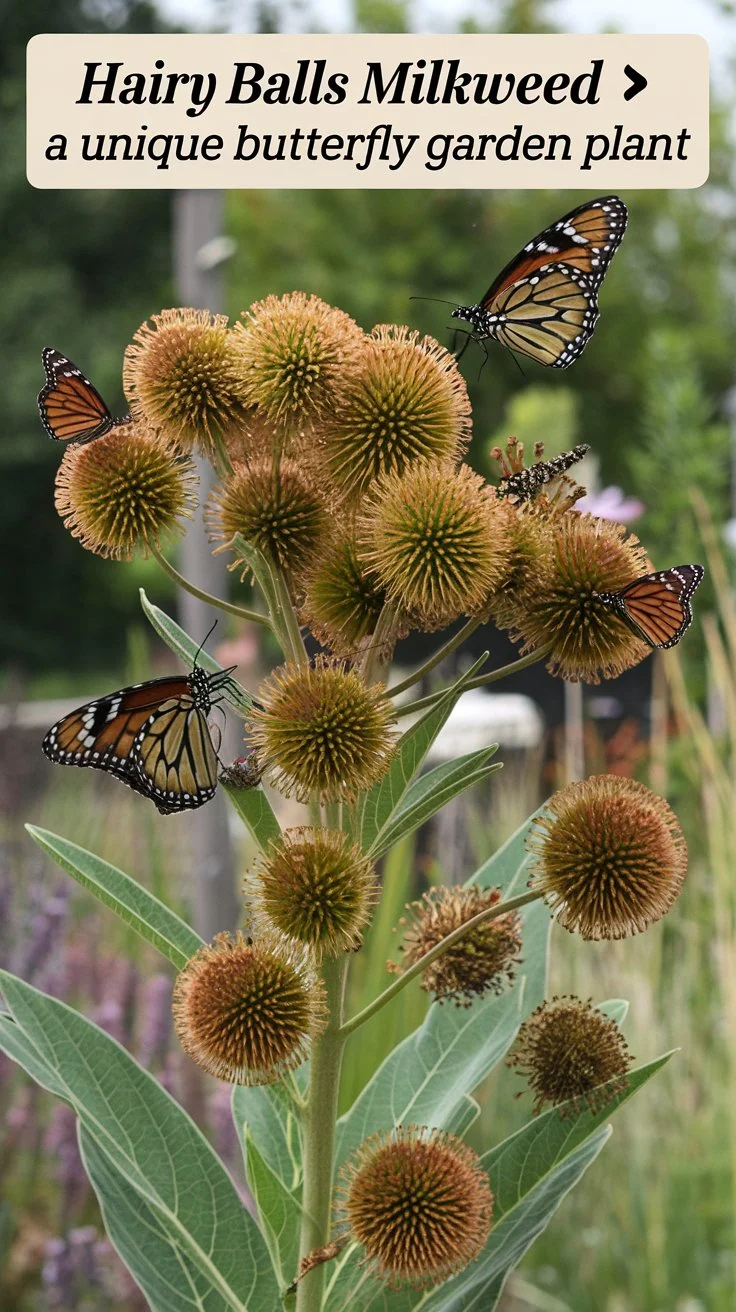Discover how to grow and care for Hairy Balls Milkweed in 2024. Learn expert tips on cultivating this unique butterfly-attracting plant and maximizing its ornamental value.
Hairy Balls Milkweed (Gomphocarpus physocarpus, formerly Asclepias physocarpa) is an intriguing ornamental plant known for its distinctive inflated seed pods covered in soft, hair-like projections. This fast-growing milkweed variety serves as a vital host plant for monarch butterflies while adding whimsical interest to gardens. Its unusual appearance and butterfly-attracting properties make it an increasingly popular choice for both pollinator gardens and unique ornamental displays in 2024.
Hello, I’m Ashley Scott, a horticulturist with over 15 years of experience in butterfly gardening and native plant cultivation. Today, I’m excited to share my knowledge about Hairy Balls Milkweed, a fascinating plant that has captured the attention of both butterfly enthusiasts and ornamental gardeners alike with its peculiar charm and ecological benefits.
Understanding Hairy Balls Milkweed

Plant Characteristics
According to the Missouri Botanical Garden, key features include:
- Height: 4-6 feet tall
- Spread: 2-3 feet wide
- Blooming Period: Summer to fall
- USDA Hardiness Zones: 8-10
- Growth Rate: Fast
Distinctive Features
- Unusual inflated seed pods
- Soft, fuzzy spines covering pods
- Small white flowers with purple centers
- Butterfly-attracting properties
The North American Butterfly Association recognizes this plant as an important monarch butterfly host.
Growing Requirements
Climate and Location
As noted by the University of Florida IFAS Extension:
- Full sun exposure
- Well-draining soil
- Protected from strong winds
- Adequate spacing for air circulation
Soil Requirements
- Sandy to loamy soil
- pH range: 6.0-7.0
- Good drainage essential
- Moderate fertility
Planting and Care
Planting Tips
The Xerces Society recommends:
- Spring Planting
- After last frost
- Space 2-3 feet apart
- Plant at same depth as container
- Water thoroughly
- Site Selection
- Protected location
- Full sun exposure
- Room for vertical growth
- Good air circulation
Maintenance
Watering
- Regular watering until established
- Drought tolerant once mature
- Avoid overwatering
- Monitor soil moisture
Fertilization
- Light feeding in spring
- Balanced organic fertilizer
- Avoid excess nitrogen
- Compost application beneficial
Butterfly Garden Integration
Monarch Butterfly Benefits
According to the Monarch Butterfly Garden:
- Larval host plant
- Nectar source
- Migration support
- Population sustainability
Companion Plants
Pair with:
- Butterfly Weed (Asclepias tuberosa)
- Zinnia
- Lantana
- Mexican Sunflower
Seasonal Care
Spring
- Plant new specimens
- Cut back old growth
- Apply compost
- Monitor for pests
Summer
- Deadhead spent blooms
- Support tall stems
- Watch for monarch caterpillars
- Maintain consistent moisture
Fall
- Collect seeds
- Prepare for winter
- Reduce watering
- Leave pods for winter interest
Winter
- Protect in cold zones
- Mulch root zone
- Consider container moving
- Plan for spring
Common Problems
Pest Management
The University of California IPM identifies:
- Aphids
- Spider mites
- Whiteflies
- Milkweed bugs
Disease Prevention
- Powdery mildew
- Root rot
- Leaf spot
- Verticillium wilt
Propagation Methods
Seed Starting
- Collect pods when brown
- Cold stratification recommended
- Start indoors 6-8 weeks before last frost
- Plant immediately in warm climates
Other Methods
- Stem cuttings
- Root division
- Crown division
- Air layering
Ornamental Uses
Garden Design
- Butterfly gardens
- Cottage gardens
- Cut flower gardens
- Dried arrangements
Container Growing
- Large containers needed
- Good drainage essential
- Mobile placement options
- Winter protection easier
Conservation and Ecology
Environmental Benefits
The National Wildlife Federation highlights:
- Pollinator support
- Biodiversity enhancement
- Wildlife habitat
- Ecosystem services
Native Plant Connections
- Milkweed family importance
- Local ecology support
- Habitat restoration
- Biodiversity preservation
Additional Resources
- Lady Bird Johnson Wildflower Center
- Pollinator Partnership
- Butterfly Conservation Initiative
- Native Plant Trust
Related Articles
- Complete Guide to Monarch Butterfly Gardening
- Growing Milkweed Species
- Creating a Butterfly Garden
- Native Plants for Pollinators
Hairy Balls Milkweed offers a unique combination of ornamental interest and ecological value. While its common name might raise eyebrows, this fascinating plant deserves a place in gardens where its unusual appearance and butterfly-supporting qualities can be fully appreciated. With proper care and placement, it can become a remarkable focal point in your garden while supporting important pollinator populations.
Note: As with all milkweed species, take precautions as the milky sap can cause skin irritation, and all parts of the plant are toxic if ingested.
For more gardening tips and plant care guides, visit usagardenhub.com




2 Comments on “Hairy Balls Milkweed : A Unique and Fascinating Addition to Your Butterfly Garden”